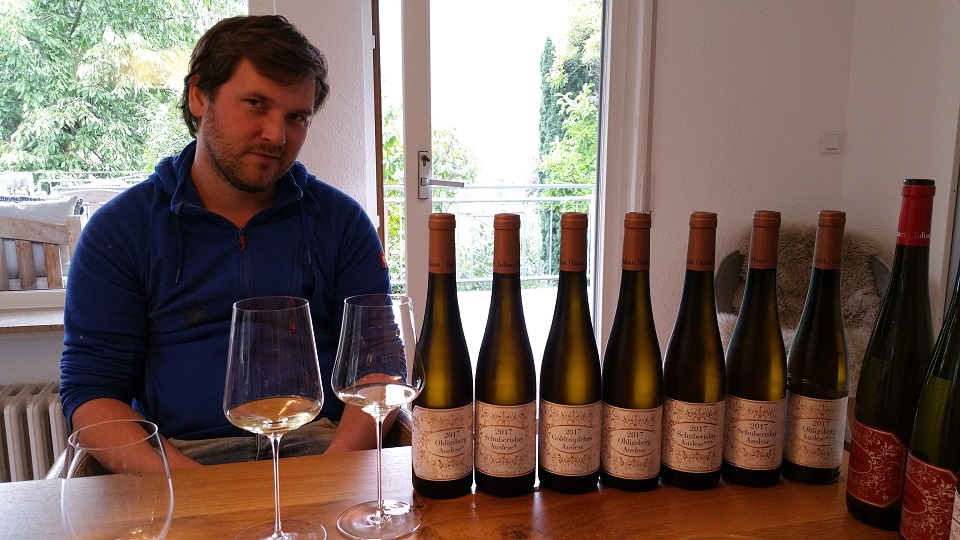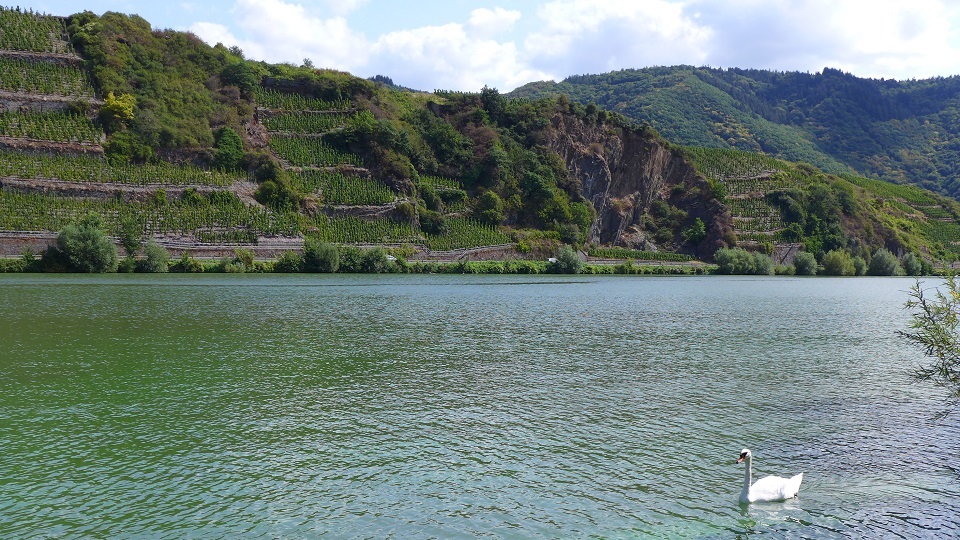Browse using the new Vinous website now. Launch →
Printed by, and for the sole use of . All rights reserved © 2015 Vinous Media
Multifarious 2017 Mosels: Graach to Grünhaus
BY DAVID SCHILDKNECHT | APRIL 08, 2020
Local weather conditions and harvest decisions go a long way toward explaining why quite a few Mosel growers struggled to achieve excellence in 2017 and a minority of those scored memorable successes. Continuing upstream, I offer my second of two reports on the 2017 vintage Mosel Rieslings, here including those from estates based along the Ruwer.
General
accounts of this unusual growing season can be found in my previous vintage
2017 reports, and my report covering estates from Winningen to Wehlen details
important meteorological and qualitative considerations specific to the Mosel.

The arc of vineyards downstream from Leiwen, around Trittenheim, and extending to Neumagen and Dhron harbors hidden treasures. Andrea Adam's terraced Häschen and Stefan Steinmetz's newly-acquired Grosser Hengelberg - both monopoles - are visible where the river disappears to the right.
Heterogeneity Writ Large
One source of 2017’s qualitative heterogeneity is irregularity of ripening in the wake of April frost. On any given vine – not to mention from row to row or parcel to parcel – might hang fruit resulting from buds that were spared, but also the fruits of secondary, post-frost budding. A great many growers emphasized heterogeneity within clusters as well. This might in part have been a consequence of irregular berry size, but sectors that suffered late summer hail were faced with scarred berries, and in many places nests of rot within the clusters. The most striking qualitative disparity from a wine lover’s perspective, though, is that observed between one village or one estate and the next. And the most important source of that heterogeneity has a human as well as a meteorological aspect. How much rot-engendering or otherwise disruptive rain fell during September differed significantly from one bend in the Mosel to another. And how the vines were groomed and the soil handled throughout the growing season will often have made the difference between a rot-plagued and a relatively healthy crop, or between having felt compelled to harvest hastily and having been able to strategize, or pause between multiple passes on the same parcel.
Take the Ruwer as an example. It seems clear from the testimony of growers and a glance at the meteorological statistics for nearby Trier that vineyards along this diminutive but prestigious Mosel tributary were plagued with significantly more inopportune rain than were their neighbors to the south along the Saar, or than growers in certain sectors of the Middle Mosel. And that could certainly explain why, despite some significant vinous successes, the Ruwer Rieslings of 2017 are not notable for their precision or clarity. Wolfgang Mertes of von Kesselstatt – an estate based along the Ruwer and farming a significant share of that sector’s vineyards – views harvest conditions in 2017 as simply an extreme example of a trend. “You don’t have the leisure that you used to have, to spend six weeks harvesting,” he opined. “That simply won’t work anymore.” On the other hand, the roles played by human expertise and exertion should never be overlooked. And as I have worried in the introductions to previous reports, it is hard to avoid an impression that several prominent Ruwer estates have not progressed viticulturally in recent decades and were turning out more exciting as well as more distinctive wines in the late 1980s and early 1990s (many of which I continue to uncork with enormous pleasure) than they are today.

Leiwen's Laurentiuslay (in the left half of this photo) has regained its reputation thanks to the late 20th century efforts of Gerhard Grans, Carl Josef Löwen and Nik Weis.
Is less Really More? (Asked Twice)
I have repeatedly pointed out that vintage 2017’s freakishly high levels of dry extract are predictably ascribed by most growers to their yields having been cut drastically by April frost, but that this hypothesis, however plausible, is falsified by extreme levels of dry extract even from those vineyards or villages whose buds were spared. And in any event, no correlation can be established between extract levels and overall quality. (Though one can confidently assert that high extract helped buffer 2017’s high acidity, just as low extract – which entails low levels of buffering potassium – was to mitigate 2018’s low acidity, leaving the best wines from that vintage tasting brighter and livelier than their analyses would have led one to expect.) Another view adopted by many growers and similarly plausible on its surface is one associating vintage quality with low yields. The Welters and Haarts in Piesport were by no means the only Mosel growers to point to top vineyards last damaged by spring frost in 1971. And the story told about that legendary vintage – by general consent still the finest for German Riesling in the last six decades – nearly always implicates frost-trimmed yields. Nik Weis seems confident that the quality of his vintage 2017 collection is directly related to the small crop. “No grower,” he averred, “would ever have cut yields so savagely even with the most rigorous de-budding or crop-dropping. But nature did it.” Yet this hypothesis, too, is dubious. In fact, if one considers those vintages that arguably challenge 1971 in quality, two high-yielding growing seasons stand out: 1959 and 1969. And in reviewing my assessments of vintage 1983 on the Mosel, Saar and Ruwer – the first that I was privileged to follow from cask to bottle – I realize that one of the reasons I underestimated the quality and aging potential of those wines, not just in their youth but even quite stubbornly during 10 or 15 years in bottle, was due to unfounded skepticism concerning growing seasons in which grapes are abundant and juice-to-skin ratios high.
A phenomenon increasingly discussed among German growers, wine professionals and critics is the number of already large Mosel estates that in recent years have been steadily expanding their vine acreage. These discussions are often couched in terms of suspicions that quality cannot be maintained when estates reach the mega-proportions that we sometimes see today. Those suspicions are often accompanied by the championing of those relatively few prominent Mosel estates whose proprietors still personally carry out the majority of viticultural and cellar labor. If one considers some prominent examples from the latter category, one notes that A. J. Adam, Hofgut Falkenstein, Julian Haart, Knebel, Martin Müllen, Willi Schaefer, Vollenweider and Weiser-Künstler are all under 23 acres in size, and six of those eight farm less than a dozen acres. It’s certainly tempting, and possibly partly correct, to imagine that the high quality of their wines is associated with the combination of hands-on direction and modest vine surface. On the other hand, those estates that have become poster children for rapid expansion – Markus Molitor (farming, at last count, roughly 260 acres), Van Volxem (220) and Nik Weis St. Urbans-Hof (85) – remain at the top of the Greater Mosel’s qualitative pecking order. It’s conceivable that some lessons might be drawn from figures like these about certain sizes of wine growing business conducing to stability and high-quality production. Conceivable... but dubious, since one can cite such conspicuous “mid-sized” overachievers as Clemens Busch (ca. 45 acres), Fritz Haag (50), Schloss Lieser (65), Dr. Loosen (55), Joh. Jos. Prüm (50) and Selbach-Oster (60).

Julian Haart's
quantitatively small but diverse vintage 2017 collection includes a remarkable
string of Auslesen.
What is more interesting is to ask after the conditions under which certain Mosel mega-establishments – or those that have expanded rapidly and into far-flung sites (Schloss Lieser, for instance, represents twice the acreage and number of villages that it did four years ago) – have managed to retain their quality edge, when size and distance between vineyard sites are so often cited as major contributors to the dissolution or qualitative decline of so many once-renowned estates in the Rheingau and nearby Rheinhessen. Schloss Groenesteyn, Freiherr Heyl, Prinz von Hessen, Langwerth von Simmern, Mumm, Schloss Reinhartshausen, Schloss Schönborn, Schloss Vollrads – ranging in size from 80 to 200 acres – all struggled unsuccessfully over the past quarter-century, or continue struggling, to retain or regain a qualitative edge. (Its more than 600 acres puts the Hessian state winery, a.k.a. Kloster Eberbach, in a class by itself quantitatively, but not in terms of the aforementioned struggle.) A prime consideration may, ironically, be the sheer rigor required to work the Mosel’s steep slopes. Unlike in the Rheingau, one cannot even be tempted to switch to mechanized harvesting, and grooming one’s vines has to remain largely manual labor as well. But what the really outstanding oversized Mosel estates also share is a remarkable continuity of personnel calling the shots as vineyard manager or cellarmaster, and a stable, skilled, motivated as well as large crew of harvesters, something increasingly difficult to muster in recent times, which have featured both an extended period during which the German government sought to inhibit the flow of seasonal workers from Poland and Romania and another during which EU membership and relative prosperity made seasonal harvest work less attractive to foreign nationals.

Thanks to Nik Weis's
work with its terraced subsection known as "Layet" (right of center),
the Mehringer Blattenberg offered a spectacular vintage 2017 explanation for
its former renown.
Pinot Potential
Another topic increasingly under discussion is the future of Pinot Noir on the Mosel and Saar. Readers who have been following my reports closely over the past several decades will realize that I consider the Pinot Noir efforts of more than a half-dozen growers in the Greater Mosel to be worthy of serious consumer attention. And 20 years ago, I would have said that of at most two estates, with the proviso that their volume of successful Pinot Noir was too tiny to be taken seriously from a commercial standpoint. Today, it is not just in the Rheingau – where Spätburgunder has played a prestigious role for centuries – that one finds Riesling growers who are also being sought out by oenophiles specifically on account of their Pinot Noir. That is certainly the case for Markus Molitor, Später-Veit and Günther Steinmetz (where the share of Pinot now stands at 15%, half again as much as two years ago). And in Daniel Twardowski we now have a head-turning Mosel grower who is devoted exclusively to Pinot Noir, and who has influenced a couple of his most talented neighbors, Andreas Adam and Julian Haart, to plant their first.
A warming climate is often cited as contributing to the recent success of Mosel Pinot Noir. It’s tempting to imagine that it must have been nearly impossible to succeed with Pinot Noir during a period when even good Mosel sites and growers regularly struggled to ripen Riesling to 10 percent potential alcohol – a period that extended for at least 150 years before ending with inexplicable abruptness in 1988. But in fact, Pinot routinely ripens ahead of Riesling. What’s more, the historical record reveals significant periods during which the Mosel and Saar were taken seriously for Pinot. Under the sign of global warming, Mosel growers face a concern even with Riesling – to say nothing of Pinot Noir – that they share with growers the world over, namely that must weights will ascend too rapidly to levels of potential alcohol that are difficult to reconcile with the virtues of textural refinement, elegance and drinkability. A few general observations strike me as appropriate in that regard. First, I am not convinced that the still-fashionable first generation of “Dijon” clones – developed at a time when nobody imagined that excess must weight could ever become a problem, and whose popularity has persisted even in the face of so much jammy and high-alcohol Pinot worldwide – are any better suited to the Mosel than to warmer regions. Traditional German Pinot clones have demonstrated that their lack of fashionability is no impediment to impressive quality, and Geisenheim has been working hard to develop superior clonal alternatives. As with so many grape varieties, both more rapid and longer-term advantage would likely result from pursuing clonal diversity and massal selection in tandem.

Mosel Pinot Noir is becoming increasingly serious, even before factoring
in young Riesling talents like Julian Haart, who just planted a Pinot vineyard,
and Andreas Adam, here shown overseeing maceration of his inaugural, 2018
red.
Viewing high grape sugar as vinous capital, trying to extract too aggressively, or exposing one’s Pinot Noir to too much young wood in the ostensible interest of conveying “structure” are approaches every bit as problematic on the Mosel as they are elsewhere. Just as it seems that German growers, who profess in their Riesling Grosse Gewächse to strive for power and Druck (which literally means “pressure” but can also mean “oppressiveness”), have been the very last worldwide to recognize that bigger is not better, so too I worry that growers of Pinot in the Greater Mosel will be slow to unlearn habits inimical to finesseful aromas, flavors and textures in Pinot. Especially encouraging, though, are recent attempts at rendering Pinot in utterly distinctive styles arguably peculiar to the Mosel or Saar; a palate-expanding experience awaits oenophiles who seek out Ulrich Stein’s “Red Light,” Hofgut Falkenstein’s “Red Wine” (yes, that’s how those two Pinots are labeled) or recent vintages of the Mülheimer Sonnenlay Pinot Noir from Steinmetz. Finally, I should not fail to mention the “Steinmetz und Hermann” collaboration from the Burgener Römerberg, the inaugural 2016 of which I review in this report, nor the Maximin Grünhaus Pinot Noir, an alcoholically hefty wine from very young vines that in vintages 2014-2017 has struck me as improbably successful.

Practically a familiar occurrence nowadays: Oliver Haag caps the vintage 2017 collection at Weingut Fritz Haag with two breathtakingly beautiful Trockenbeerenauslesen.
A
Ruwer Runs Through Them
Apropos of my decision to include establishments based on the Ruwer in this report rather than in a dedicated one, the reason is not solely because such a small number of estates (fewer than ever before) dominate vine acreage along the lower reaches of that narrow tributary. Notwithstanding the renown that some of those estates have long enjoyed, their vineyards were traditionally treated as part of the Mosel. This is less surprising when one considers that until the last half-century, vineyards in the city of Trier and its suburbs – naturally enough considered “Mosel” – were significantly more famous and more extensive than they are today, presenting the impression of one huge constellation of vineyards east of the city, extending seamlessly into the Ruwer Valley. (Incidentally, there are indications of recent revival in at least a couple of once-prized Trier sites.) In 1909, the region known as “Mosel-Saar-Ruwer” was christened, giving the diminutive Ruwer deceptively prominent billing. Under Germany’s 1971 law, the somewhat odd couple of “Saar und Ruwer” also became an official subregion (Bereich) of Mosel-Saar-Ruwer. That situation persisted until vintage 2007, when the Saar and Ruwer were officially subsumed under “Mosel.” Proprietors chafed at no longer being allowed to mention those rivers on the relevant labels, but Ruwer vintners had to wait longer for redress than did those on the Saar, because a small municipality called “Ruwer” had exclusive rights to that name. In 2019, the last vestiges of vineyards in that Trier suburb were pulled up, and growers all along the eponymous river were granted permission to henceforth reference “Ruwer” on labels as their wines’ place of origin.

Erni and Berni: The ever-reliable 33 year long collaboration of Ernst Loosen and Bernhard Schug bore exceptional fruit in 1987. Even the decadent wines display animation and delicacy.
This report, covering estates from Graach upstream, including the Ruwer, is the second of two based on visits with 45 growers – 40 along the Mosel proper and five along the Ruwer – between late August and the end of October 2018. My impressions were supplemented by subsequent stateside assessment of samples, including some from one additional estate. Since I group my reports according to winery location, this part of my Mosel report incorporates extensive notes on the important Saar Rieslings of Reichsgraf von Kesselstatt and Nik Weis (St. Urbans-Hof), just as my report “From Winningen to Wehlen” incorporated the Saar Rieslings of Markus Molitor.
Conventions regarding nomenclature and scoring are those followed in my past reports and detailed in the introductions to my coverage of vintage 2015 and 2014 German Rieslings. I reference A.P. (official registration) numbers only where this is necessary to disambiguate two otherwise eponymous wines; and the registration number is assumed to be that of the year following the vintage, unless otherwise indicated. Any wine not tasted since it was bottled is, as usual, allotted a point spread rather than a single numerical rating. I only rarely review a wine I have rated 86 points or lower, but make exceptions in instances where such a wine represents good value, or a disappointment about which I think readers deserve to know in detail.
You Might Also Enjoy
Multifarious 2017 Mosels, Part 1: Winningen to Wehlen, David Schildknecht, January 2020
Rheingau and Mittelrhein Riesling: Rising to 2017’s Challenges, David Schildknecht, August 2019
Mosel Riesling 2016 Part 2: Longuich to Graach, David Schildknecht, January 2018
Mosel Riesling 2016 Part 1: From Extremes, Equilibrium, David Schildknecht, January 2018
Vintage Report – Drama in Three Acts: 2016 in Germany and Austria, David Schildknecht, September 2017
2015 Rheingau and Mittelrhein Riesling, David Schildknecht, September 2017
Show all the wines (sorted by score)
- A. J. Adam
- Ansgar Clüsserath
- Carl Loewen
- Clüsserath-Weiler
- Dr. Loosen
- Erben von Beulwitz
- Fritz Haag
- Grans-Fassian
- Günther Steinmetz
- Haart
- Hermann Ludes
- Jochen Clemens
- Julian Haart
- Karlsmühle
- Karthäuserhof
- Max Ferd. Richter
- Maximin Grünhaus - von Schubert
- Nik Weis St. Urbans-Hof
- Reichsgraf von Kesselstatt
- Schloss Lieser
- Später-Veit
- Steinmetz und Hermann
- Wegeler
- Willi Haag
- Willi Schaefer
- Wwe. Dr. H. Thanisch – Erben Müller-Burggraef
- Wwe. Dr. H. Thanisch – Erben Thanisch
